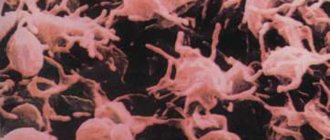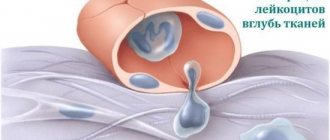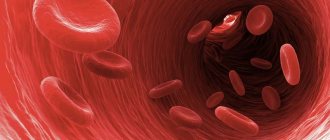Leukocytes are the main element of the immune system. They protect the body from infections, as well as from cancer cells. In some cases, the number of white blood cells exceeds the norm. This may be physiologically normal, but if a person feels unwell for several days, he should immediately consult a doctor.
Indications for the study
A general blood test with the determination of leukocytes, and, according to indications, the leukocyte formula, is prescribed to patients undergoing a preventive medical examination, seeking outpatient medical care or admitted to a hospital. Indications for determining the concentration of leukocytes and their forms are:
- infectious diseases;
- inflammatory process of any localization;
- suspicion of helminthiasis or parasitic infestation;
- malignant processes;
- allergic reactions;
- assessment of the effectiveness of anti-inflammatory treatment;
- suspicion/presence of leukemia.
White blood cell counts can detect hidden infections and hidden undiagnosed conditions, such as autoimmune diseases, immunodeficiencies, and blood disorders.
Types
Determining the size of each type of white blood cell allows you to more accurately determine the causes of the disease, since each type of cell performs a specific function:
- neutrophils carry out phagocytosis of relatively small particles. After their death, cells release a significant amount of biologically active substances, enhancing the response of the immune system;
- lymphocytes are capable of synthesizing antibodies that neutralize pathogens and their toxins. In addition, they control the functioning of other cells of the immune system;
- Monocytes destroy large numbers of small foreign bodies or large pathogens using phagocytosis. A distinctive characteristic is the ability to perform a protective function even at acidic pH values, when neutrophils lose their antimicrobial activity;
- eosinophils implement antiparasitic defense of the human body, and also take a major part in the development of an allergic reaction;
- basophils promote the influx of white blood cells into the site of inflammation through their own degranulation, which results in the release of a large number of mediators of allergy and inflammation.
Read further: Eosinophil cationic protein - what it shows and what to do if it is elevated in a child
Preparation
There is no special preparation before donating blood to perform OAC. The patient must comply with a number of simple requirements:
- refrain from eating 4 hours before the procedure;
- stop smoking half an hour before the procedure;
- limit the consumption of fatty and fried foods and alcohol the night before the test;
- limit physical and psycho-emotional stress 2 hours before submitting the biomaterial.
It is allowed to drink still water before the procedure.
More detailed recommendations before taking a general blood test are given here.
Diagnostics
To establish the white blood cell index, a general clinical blood test is performed, which involves studying biological material taken either from a finger or from a vein.
The designation of leukocytes in a blood test is WBC, and in order for the real level of such substances to be detected, the patient needs to undergo simple preparation for such a diagnostic test.
- Normal blood insulin levels - high and low values
Preparatory activities include:
- Complete refusal to eat on the day of the study - the analysis is carried out only on an empty stomach.
- Avoid taking any medications several weeks before the proposed examination. If this is not possible, the clinician should be informed about the use of medications.
- Female representatives do not donate blood during menstruation.
- A few days before the test, you should limit physical activity and avoid exposure to stressful situations.
The results are deciphered by a hematologist who transmits the received data to the attending physician. It must be taken into account that in order to identify an illness that could provoke a deviation from the norm, the information obtained during such a procedure will not be enough, which is why a comprehensive examination will be required.
Primary diagnosis includes activities carried out personally by the clinician:
- familiarization with the medical history;
- collection and analysis of life history;
- a thorough physical examination of the patient;
- a detailed survey of the patient - this is necessary for the doctor to obtain all data regarding the clinical picture;
Additionally, a person may be prescribed more extensive laboratory tests, various instrumental procedures and consultations with other specialists.
Leukocyte norms
Important! Standards may vary depending on the reagents and equipment used in each particular laboratory. That is why, when interpreting the results, it is necessary to use the standards adopted in the laboratory where the analysis was carried out. You also need to pay attention to the units of measurement.
White blood cell reference values are determined by the patient's age.
Invitro laboratory data:
| Age | Leukocyte concentration, thousand/µl (103 cells/µl) |
| 1 day – 12 months | 6,0 – 17,5 |
| 12 months – 2 years | 6,0 – 17,0 |
| 2 years – 4 years | 5,5 – 15,5 |
| 4 years – 6 years | 5,0 – 14,5 |
| 6 years – 10 years | 4,50 – 13,5 |
| 10 years – 16 years | 4,50 – 13,0 |
| 16 years – 120 years | 4,50 – 11,0 |
Helix Laboratory:
| Age | Reference values, *109/l |
| Less than 1 year | 6 — 17,5 |
| 1-2 years | 6 — 17 |
| 2-4 years | 5,5 — 15,5 |
| 4-6 years | 5 — 14,5 |
| 6-10 years | 4,5 — 13,5 |
| 10-16 years | 4,5 — 13 |
| More than 16 years | 4 — 10 |
In the medical reference book, MD. Danilova L.A. The average standards are given:
| Age | Reference values, *109/l |
| Adults | 4,0-9,0 |
| up to 1 year | 6,0-17,5 |
| 1-2 years | 6,0-17,0 |
| 2-4 years | 5,5-15,5 |
| 4-6 years | 5,0-14 |
| 6-10 years | 4,5-13,5 |
| 10-16 years | 4,5-13,0 |
The American University of Rochester Medical Center calls for the following leukocyte counts to be considered normal:
- From 9000 to 30,000/mm3 for newborns
- 6,200 to 17,000/mm3 for children under 2 years old
- 5,000-10,000/mm3 for children over 2 years old to adults.
If the level of leukocytes significantly deviates from normal values, it is recommended to conduct a more detailed study - leukocyte formula. The study shows the number of each type of leukocyte.
Below is the normal composition of the leukocyte formula, in percentage:
- Neutrophils - 55-70% of the total number of leukocytes
- Lymphocytes - 20-40%
- Monocytes - 2-8%
- Eosinophils - 1-4%
- Basophils - 0.5-1%
Important! The interpretation of the results is always carried out comprehensively. It is impossible to make an accurate diagnosis based on only one analysis.
general characteristics
White blood cells protect the body by phagocytosis - the absorption and digestion of pathogenic microorganisms of various sizes, as well as by stimulating the immune system - the production of specific antibodies that directly interact with the causative agent of the disease.
Determining the number of white cells is the first step in diagnosing any pathology. A general blood test determines the total number of leukocytes. However, if there is a deviation from the norm, it is necessary to use a more detailed research method that allows you to determine the concentration of each cell type separately. For this purpose, an analysis is carried out to decipher the leukocyte formula, carried out by flow cytometry.
White blood cells are increased (leukocytosis)
When the concentration of leukocytes in the peripheral blood increases, they speak of leukocytosis. The causes of this condition are:
- prolonged stress;
- excessive physical activity;
- acute/chronic inflammation;
- tissue damage, burns;
- infection of the body (viruses, protozoa, bacteria, fungi, parasites);
- malignant neoplasm;
- acute circulatory disorders in organs (myocardial infarction, stroke);
- anemia;
- poisoning by poisons, alcohol;
- allergic reactions;
- autoimmune pathology (rheumatoid arthritis, systemic lupus erythematosus);
- leukemia.
Physiological conditions in which a slight increase in the concentration of leukocytes is not considered a pathology:
- pregnancy;
- postpartum period (first 14 days);
- menstruation;
- vaccination completed;
- overheating, hypothermia;
- dramatic climate change.
Leukocytes in the blood during pregnancy
Elevated leukocytes in the blood during pregnancy are a variant of the physiological norm. This condition is called physiological leukocytosis. This fact is explained by the need for enhanced functioning of the immune system, which is aimed at protecting the woman and child herself from infections. For this purpose, a significantly larger number of white blood cells are synthesized.
When interpreting the analysis, it is necessary to take into account the gestational age, since each trimester has its own reference values. Thus, normal values for the first trimester are similar to standard values, taking into account the patient’s age. The value of white blood cells should not exceed 10 – 12*109/l.
Leukocytosis in pregnant women begins at 13–14 weeks, when all the baby’s organs are formed and begin to function fully. Leukocytes during pregnancy in the second trimester can normally reach 15 – 16*109/l.
In the third trimester, normal leukocytes in the blood are considered to be in the range from 10 to 15*109/l.
It should be noted that if a pregnant woman’s blood shows a stable deviation of leukocytes from the norm or is at the upper limit of normal in combination with a high ESR, the doctor prescribes additional laboratory and instrumental research methods.
Leukocytes are low (leukopenia)
When the level of leukocytes in the peripheral blood decreases, they speak of leukopenia. The causes of this condition are:
- taking certain medications (NSAIDs, antidepressants, anticonvulsants);
- decreased immunity due to any reason;
- viral infectious diseases (measles, rubella, mononucleosis, influenza and others);
- anaphylactic shock;
- bone marrow aplasia/hypoplasia (congenital disease);
- malignant process in the bone marrow;
- chronic infection (HIV, tuberculosis);
- lymphogranulomatosis;
- some leukemias (aleukemic form);
- collagenoses;
- sepsis in the extreme stage;
- plasmacytoma (malignant blood tumor);
- metabolic disorders (deficiency of B vitamins, folic acid or copper).
Sources:
- Data from the independent laboratory Invitro.
- Data from Helix laboratory.
- Danilova L.A., Doctor of Medical Sciences, Prof. Analyzes of human blood, urine and other biological fluids at different age periods, SpetsLit, 2014.
- Choladda Vejabhuti Curry, MD. Differential Blood Count. — Medscape, Nov 2021.
Pathological leukocytosis: main causes
In some cases, exceeding the norm of leukocytes indicates the development of pathology:
- almost all infections (mainly associated with bacteria and fungi, less often with viruses);
- inflammatory processes of various nature;
- allergy;
- leukemia, lymphoma and other malignancies;
- myocardial infarction;
- penetration of parasites;
- receiving various types of injury (physical, electrical, thermal).
Having completed the physiological cycle, leukocytes enter the spleen, where they are destroyed and excreted from the body. Therefore, when the spleen is removed and its functions are disrupted, leukocytosis is also observed. Moreover, it has a persistent and pronounced character (in this case, the level of leukocytes of all types increases).
As for leukopenia (reduced number of white blood cells in the blood), it can be one of the signs of such diseases and disorders:
- exhaustion due to severe pathologies, prolonged fasting;
- viral infections;
- autoimmune processes;
- immunodeficiency, including those associated with HIV;
- severe purulent-septic conditions;
- bone marrow damage, especially after taking medications or other illnesses;
- radiation sickness;
- radiation therapy, chemotherapy;
- deficiency of vital substances - proteins, vitamins, minerals;
- insufficient activity of the thyroid gland;
- certain forms of anemia;
- certain forms of leukemia.











